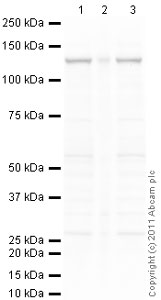
All lanes : Anti-CD31 antibody (ab32457) at 1 µg/mlLane 1 : Jurkat (Human T cell lymphoblast-like cell line) Whole Cell LysateLane 2 : HUVEC (Human Umbilical Vein Endothelial Cell) Whole Cell LysateLane 3 : Raji (Human Burkitt's lymphoma cell line) Whole Cell Lysate Lysates/proteins at 20 µg per lane.SecondaryGoat Anti-Rabbit IgG H&L (HRP) preadsorbed (ab97080) at 1/5000 dilutionPerformed under reducing conditions.
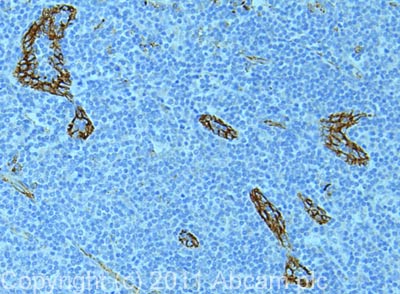
IHC image of ab32457 staining in human tonsil formalin fixed paraffin embedded tissue section, performed on a Leica BondTM system using the standard protocol F. The section was pre-treated using heat mediated antigen retrieval with sodium citrate buffer (pH6, epitope retrieval solution 1) for 20 mins. The section was then incubated with ab32457, 5µg/ml, for 15 mins at room temperature and detected using an HRP conjugated compact polymer system. DAB was used as the chromogen. The section was then counterstained with haematoxylin and mounted with DPX. For other IHC staining systems (automated and non-automated) customers should optimize variable parameters such as antigen retrieval conditions, primary antibody concentration and antibody incubation times
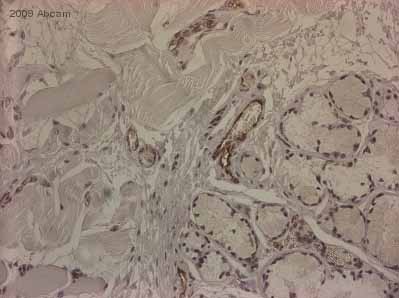
ab32457 staining CD31 in human tonsil tissue section by Immunohistochemistry (Formalin/PFA-fixed paraffin-embedded sections). Tissue underwent fixation in formaldehyde, heat mediated antigen retrieval in Citrate buffer pH 6.0 and blocking (5 minutes/peroxidase block then 10 minutes/protein block) for 15 minutes at 20°C. The primary antibody was diluted, 1/2000 and incubated with sample for 45 minutes at 20°C. A HRP conjugated goat polyclonal to rabbit IgG was used undiluted as secondary.See Abreview
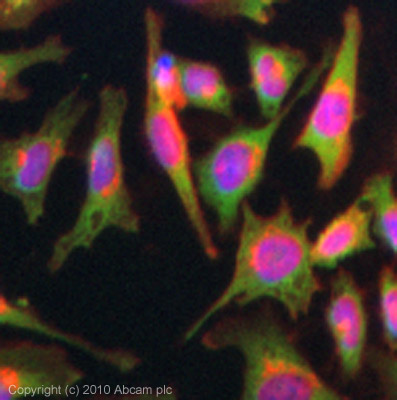
ICC/IF image of ab32457 stained HeLa cells. The cells were 4% PFA fixed (10 min) and then incubated in 1%BSA / 10% normal goat serum / 0.3M glycine in 0.1% PBS-Tween for 1h to permeabilise the cells and block non-specific protein-protein interactions. The cells were then incubated with the antibody (ab32457, 5µg/ml) overnight at +4°C. The secondary antibody (green) was Alexa Fluor® 488 goat anti-rabbit IgG (H+L) used at a 1/1000 dilution for 1h. Alexa Fluor® 594 WGA was used to label plasma membranes (red) at a 1/200 dilution for 1h. DAPI was used to stain the cell nuclei (blue) at a concentration of 1.43µM. This antibody also gave a positive result in 4% PFA fixed (10 min) HepG2 cells at 5µg/ml.
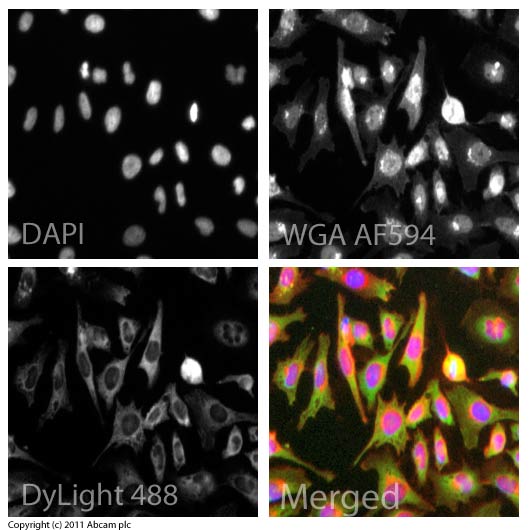
ICC/IF image of ab32457 stained HeLa cells. The cells were 4% formaldehyde fixed (10 min) and then incubated in 1%BSA / 10% normal goat serum / 0.3M glycine in 0.1% PBS-Tween for 1h to permeabilise the cells and block non-specific protein-protein interactions. The cells were then incubated with the antibody (ab32457, 5µg/ml) overnight at +4°C. The secondary antibody (green) was ab96899, DyLight® 488 goat anti-rabbit IgG (H+L) used at a 1/250 dilution for 1h. Alexa Fluor® 594 WGA was used to label plasma membranes (red) at a 1/200 dilution for 1h. DAPI was used to stain the cell nuclei (blue) at a concentration of 1.43µM.
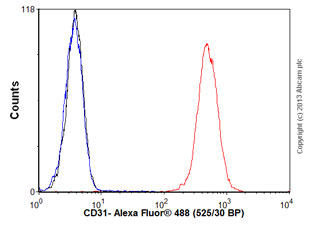
Overlay histogram showing Jurkat cells stained with ab32457 (red line). The cells were fixed with 80% methanol (5 min) and then permeabilized with 0.1% PBS-Tween for 20 min. The cells were then incubated in 1x PBS / 10% normal goat serum / 0.3M glycine to block non-specific protein-protein interactions followed by the antibody (ab32457, 0.1µg/1x106 cells) for 30 min at 22ºC. The secondary antibody used was Alexa Fluor® 488 goat anti-rabbit IgG (H+L) (ab150077) at 1/2000 dilution for 30 min at 22ºC. Isotype control antibody (black line) was rabbit IgG (polyclonal) (0.1µg/1x106 cells) used under the same conditions. Unlabelled sample (blue line) was also used as a control. Acquisition of >5,000 events were collected using a 20mW Argon ion laser (488nm) and 525/30 bandpass filter.
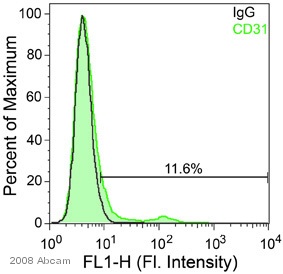
Asynchronous KM-H2 cells were pelleted and labeled by indirect immunofluorescence. Cells were stained with ab32457 (1/200) for 30min at 4'C, washed and then stained with goat anti-rabbit alexafluor 488 (1/200). Forward/Side scatter were used to eliminate cellular debris. The accompanying marker was applied such that only 2% of the IgG control was positive. Based on the accompanying image, approximately 11% of cells exhibited positive staining for anti-CD31. This image is taken from an Abreview.






